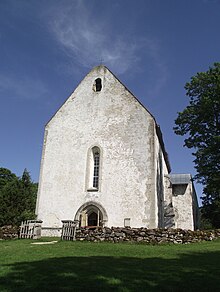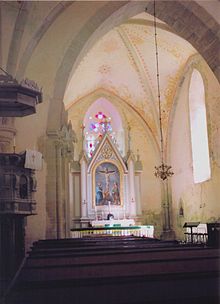Karja (Saaremaa)
Coordinates: 58 ° 31 ' N , 22 ° 42' E
Karja (German Karrishof ) is a village ( Estonian küla ) on the largest Estonian island Saaremaa . It belongs to the rural community Saaremaa (until 2017: rural community Leisi ) in the Saare district .
Population and location
The village has 187 inhabitants (as of December 31, 2011). It is located 32 kilometers northeast of the island's capital Kuressaare .
court
history
The village by the church already existed in the 13th century. In the Middle Ages the place was the center of the largest episcopal district on the island of Saaremaa.
In 1558 the Cares court was first mentioned in a document. In 1798 the Russian Tsar Paul I gave it to the general of the cavalry Otto Wilhelm von Derfelden (1737-1819). After various changes of ownership, the farm came into the ownership of the noble Baltic German family Sengbusch in 1873 . It was expropriated as part of the Estonian land reform in 1919.
Mansion
The one-story, wooden middle section of the mansion dates from the 18th century. The two-story side wings were added in the 19th and 20th centuries. After 1919 a housekeeping school was housed in the manor house. After the Second World War , the building was used as the office of the local collective farm . Today the information center of the place is located there.
church
architecture
The today Evangelical Lutheran Church of St. Catherine of Karja is located in the area of the neighboring village of Linnaka . It is the smallest church on Saaremaa Island. However, the interior appears large, as the vaulted ceiling is almost twice as high as the walls.
Around 1254 there was already a wooden church on the site. It was destroyed in 1343. Today's church was built between 1340 and 1350, probably by a French-influenced master from the Swedish island of Gotland in Gothic style . The hall church built by him has a single nave. The church does not have a bell tower.
The vaulted sacristy used to serve as a refuge. Above it is a room with a fireplace that probably hosted pilgrims. In the 16th century, an anteroom was added to the church.
art
Karja Church has largely retained its appearance to this day. This is especially true for the numerous stone carvings and many frescoes :
- It is enlivened with carved grimaces and masks right into the vaulted areas of the choir , where a devil peeking through between the legs sticks out his tongue at the viewer. On the north side of the triumphal arch you can see figures of the devil in a scene that retells the legend of St. Catherine . There they seize the emperor Maxentius , who had Katharina and the empress Faustina, who had been converted to the Christian faith, and the military leader Porphyrios killed. The Church is consecrated to you, the Patroness of Science. She stands there triumphant over the emperor, with the book and the palm branch in her hand.
- Opposite you can see the representation from the legend of Nicholas , the second saint of the church. In a small space under the Gothic city architecture, scenes full of drama throng, whether it is his main task to protect the sailors or the three sisters (south side) who, too poor to marry, receive three golden balls from the saint as a dowry get given.
The multitude of stone carvings continues in many parts of the church. The floral decoration of the choir is also very naturalistic, with numerous rose petals as well as oak and vine leaves. The shapes are repeated as capitals on the two portals.
The wall of the vestibules shows a symmetrical crucifixion scene , where the souls of the two robbers crucified next to Jesus are saved by the angel or taken by the devil. Their souls are depicted as small children. Among them, Mary and John entrust the deceased Jesus.
The magical symbols on the ceiling of the choir, which were uncovered in the 1920s and which must have been installed when the church was built, are still puzzling. There are both Christian and pagan symbols, including a pentagram and a triskele . They are arranged around a keystone and should probably protect against evil spirits.
inner space
The font dates from the 14th century. The wooden crucifix is a work of the 15th century. The carved pulpit in the Renaissance style was created in 1638 by the master Balthasar Raschky , who presumably came from Silesia . At their side are the coats of arms of the local landlords.
The organ from 1882 with its mechanical action is the work of the Estonian music maker Gustav Normann . The altar was created in 1887. The altar painting from the same year with the Golgotha scene is a copy of a painting by Guido Reni .
renovation
The church was extensively examined and restored in the 1920s by the Swedish art historian Helge Kjellin (1885–1984). Kjellin was a professor at the University of Tartu at the time . A bronze bell, cast in Stockholm in 1926 and located in a special niche in the church, commemorates the renovation .
Pastorate and cemetery
The Karja pastorate burned down in 1883. It was then rebuilt from stone.
The local cemetery is in the immediate vicinity. The old cemetery has been in use since 1770 and closed in 1903. In its center are the ruins of three old burial chapels.
The trapezoidal tombstones from the 13th and 14th centuries are particularly worth seeing. The writer Friedrich Wilhelm Willmann (1746–1819) is buried in the cemetery.
literature
- Baltic historical local dictionary. Part 1: Estonia (including Northern Livonia) (= sources and studies on Baltic history. Volume 8/1). Started by Hans Feldmann . Published by Heinz von zur Mühlen . Edited by Gertrud Westermann . Böhlau, Cologne / Vienna 1985, ISBN 3-412-07183-8 , p. 190.
Web links
- Description (eestigiid.ee)
- Gut Karja (German)
- St. Catherine's Church in Karja (German)
- Church picture gallery
Individual evidence
- ↑ Estonian Statistical Office
- ^ Thea Karin: Estonia. Cultural and scenic diversity in a historical borderland between east and west. Cologne 1994 (= DuMont art and landscape guide ) ISBN 3-7701-2614-9 , p. 321ff.
- ↑ Ivar Sakk: Eesti kirikud. Teejuht. Tallinn 2014, p. 331







